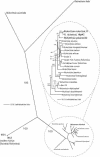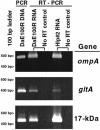Sequence and expression analysis of the ompA gene of Rickettsia peacockii, an endosymbiont of the Rocky Mountain wood tick, Dermacentor andersoni
- PMID: 15528527
- PMCID: PMC525201
- DOI: 10.1128/AEM.70.11.6628-6636.2004
Sequence and expression analysis of the ompA gene of Rickettsia peacockii, an endosymbiont of the Rocky Mountain wood tick, Dermacentor andersoni
Abstract
The transmission dynamics of Rocky Mountain spotted fever in Montana appears to be regulated by Rickettsia peacockii, a tick symbiotic rickettsia that interferes with transmission of virulent Rickettsia rickettsii. To elucidate the molecular relationships between the two rickettsiae and glean information on how to possibly exploit this interference phenomenon, we studied a major rickettsial outer membrane protein gene, ompA, presumed to be involved in infection and pathogenesis of spotted fever group rickettsiae (SFGR) but which is not expressed in the symbiont. Based on PCR amplification and DNA sequence analysis of the SFGR ompA gene, we demonstrate that R. peacockii is the most closely related of all known SFGR to R. rickettsii. We show that R. peacockii, originally described as East Side agent in Dermacentor andersoni ticks from the east side of the Bitterroot Valley in Montana, is still present in that tick population as well as in D. andersoni ticks collected at two widely separated locations in Colorado. The ompA genes of R. peacockii from these locations share three identical premature stop codons and a weakened ribosome binding site consensus sequence relative to ompA of R. rickettsii. The R. peacockii ompA promoter closely resembles that of R. rickettsii and is functional based on reverse transcription-PCR results. Sodium dodecyl sulfate-polyacrylamide gel electrophoresis and Western blotting showed that OmpA translation products were not detected in cultured tick cells infected with R. peacockii. Double immunolabeling studies revealed actin tail structures in tick cells infected with R. rickettsii strain Hlp#2 but not in cells infected with R. peacockii.
Figures





Similar articles
-
Factors influencing in vitro infectivity and growth of Rickettsia peacockii (Rickettsiales: Rickettsiaceae), an endosymbiont of the Rocky Mountain wood tick, Dermacentor andersoni (Acari, Ixodidae).J Invertebr Pathol. 2005 Nov;90(3):177-86. doi: 10.1016/j.jip.2005.09.001. Epub 2005 Nov 9. J Invertebr Pathol. 2005. PMID: 16288906 Free PMC article.
-
Rickettsia peacockii sp. nov., a new species infecting wood ticks, Dermacentor andersoni, in western Montana.Int J Syst Bacteriol. 1997 Apr;47(2):446-52. doi: 10.1099/00207713-47-2-446. Int J Syst Bacteriol. 1997. PMID: 9103635
-
Genome sequence of the endosymbiont Rickettsia peacockii and comparison with virulent Rickettsia rickettsii: identification of virulence factors.PLoS One. 2009 Dec 21;4(12):e8361. doi: 10.1371/journal.pone.0008361. PLoS One. 2009. PMID: 20027221 Free PMC article.
-
Status of the "East Side hypothesis" (transovarial interference) 25 years later.Ann N Y Acad Sci. 2009 May;1166:144-50. doi: 10.1111/j.1749-6632.2009.04522.x. Ann N Y Acad Sci. 2009. PMID: 19538274 Free PMC article. Review.
-
Colorado tick fever.Med Clin North Am. 2002 Mar;86(2):435-40, ix. doi: 10.1016/s0025-7125(03)00096-8. Med Clin North Am. 2002. PMID: 11982311 Review.
Cited by
-
Range-wide genetic analysis of Dermacentor variabilis and its Francisella-like endosymbionts demonstrates phylogeographic concordance between both taxa.Parasit Vectors. 2018 May 18;11(1):306. doi: 10.1186/s13071-018-2886-5. Parasit Vectors. 2018. PMID: 29776375 Free PMC article.
-
Tick-Pathogen Interactions and Vector Competence: Identification of Molecular Drivers for Tick-Borne Diseases.Front Cell Infect Microbiol. 2017 Apr 7;7:114. doi: 10.3389/fcimb.2017.00114. eCollection 2017. Front Cell Infect Microbiol. 2017. PMID: 28439499 Free PMC article. Review.
-
Regulator of Actin-Based Motility (RoaM) Downregulates Actin Tail Formation by Rickettsia rickettsii and Is Negatively Selected in Mammalian Cell Culture.mBio. 2022 Apr 26;13(2):e0035322. doi: 10.1128/mbio.00353-22. Epub 2022 Mar 14. mBio. 2022. PMID: 35285700 Free PMC article.
-
Disruption of the Rickettsia rickettsii Sca2 autotransporter inhibits actin-based motility.Infect Immun. 2010 May;78(5):2240-7. doi: 10.1128/IAI.00100-10. Epub 2010 Mar 1. Infect Immun. 2010. PMID: 20194597 Free PMC article.
-
Factors influencing in vitro infectivity and growth of Rickettsia peacockii (Rickettsiales: Rickettsiaceae), an endosymbiont of the Rocky Mountain wood tick, Dermacentor andersoni (Acari, Ixodidae).J Invertebr Pathol. 2005 Nov;90(3):177-86. doi: 10.1016/j.jip.2005.09.001. Epub 2005 Nov 9. J Invertebr Pathol. 2005. PMID: 16288906 Free PMC article.
References
-
- Bouyer, D. H., J. Stenos, P. Crocquet-Valdes, C. G. Moron, V. L. Popov, J. E. Zavala-Velazquez, L. D. Foil, D. R. Stothard, A. F. Azad, and D. H. Walker. 2001. Rickettsia felis: molecular characterization of a new member of the spotted fever group. Int. J. Syst. E vol. Microbiol. 51:339-347. - PubMed
Publication types
MeSH terms
Substances
Associated data
- Actions
- Actions
- Actions
- Actions
- Actions
- Actions
- Actions
- Actions
- Actions
- Actions
- Actions
- Actions
- Actions
- Actions
- Actions
- Actions
- Actions
Grants and funding
LinkOut - more resources
Full Text Sources
Miscellaneous

